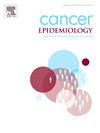有或没有BRCA1/2致病变异的巴基斯坦乳腺癌家族的预期效应
IF 2.4
3区 医学
Q3 ONCOLOGY
引用次数: 0
摘要
遗传预测是指在连续几代人中乳腺癌(BC)的早期发病,在亚洲人群中被低估了。本研究调查了巴基斯坦家族性BC患者的这一现象。方法对171对BC母女进行分析,包括BRCA1 (n = 52)、BRCA2 (n = 11)致病变异(PV)携带者和非携带者(n = 108)。此外,还包括741名母亲和女儿的一级女性亲属,受BC影响(n = 96)或未受BC影响(n = 645)。使用配对t检验比较母女两代诊断BC的年龄,使用比值比(ORs)评估女儿和母亲两代之间BC发生率的差异。结果女儿被诊断为BC的时间明显早于母亲,BRCA1的代际年龄差异为14.3岁(33.7 vs 48.0;P <; 0.0001),BRCA2患者为11.5年(37.4∶48.9;P <; 0.0001),非PV携带者为12.6年(41.3 vs. 53.9;P & lt; 0.0001)。这种差异与出生队列效应和确定偏差无关。而母亲一代的BC发病率比女儿一代高20 %(42.7 %对38.3 %;或1.20,95 % ci 0.94 - 1.53;P = 0.135),差异无统计学意义。代际间的生存时间也具有可比性(4.49年vs 3.94年; = 0.465页)。结论:巴基斯坦家族性BC患者的预期效应研究表明,无论BRCA1/2 PV携带者是否存在,女儿的BC发病明显早于母亲。这些发现强调了为巴基斯坦高危人群完善BC筛查指南的必要性。本文章由计算机程序翻译,如有差异,请以英文原文为准。
Anticipation effect in Pakistani breast cancer families with or without BRCA1/2 pathogenic variants
Background
Genetic anticipation refers to the earlier onset of breast cancer (BC) in successive generations, is underreported in Asian populations. This study investigates the phenomenon in Pakistani familial BC patients.
Methods
The study analyzed 171 mother-daughter BC pairs, including BRCA1 (n = 52), BRCA2 (n = 11) pathogenic variant (PV) carriers, and non-carriers (n = 108). Additionally, 741 first-degree female relatives of the mothers and daughters, affected (n = 96) or unaffected (n = 645) with BC, were included. Ages at BC diagnosis in mother-daughter pairs were compared using a paired t-test, while differences in BC occurrence between daughters’ and mothers’ generations were assessed using odds ratios (ORs).
Results
Daughters were diagnosed with BC significantly earlier than their mothers, with intergenerational age differences of 14.3 years in BRCA1 (33.7 vs. 48.0; P < 0.0001), 11.5 years in BRCA2 (37.4 vs. 48.9; P < 0.0001) PV carriers, and 12.6 years in non-carriers (41.3 vs. 53.9; P < 0.0001). This difference was independent of birth cohort effects and ascertainment bias. While BC incidence was 20 % higher in the mothers’ generation compared to the daughters’ generation (42.7 % vs. 38.3 %; OR 1.20, 95 % CI 0.94 – 1.53; P = 0.135), the difference was not statistically significant. Survival durations between generations were also comparable (4.49 years vs. 3.94 years; P = 0.465).
Conclusion
This first study on anticipation effect in Pakistani familial BC patients demonstrates significantly earlier BC onset in daughters than in mothers, irrespective of BRCA1/2 PV carrier status. These findings highlight the need to refine BC screening guidelines for high-risk Pakistani populations.
求助全文
通过发布文献求助,成功后即可免费获取论文全文。
去求助
来源期刊

Cancer Epidemiology
医学-肿瘤学
CiteScore
4.50
自引率
3.80%
发文量
200
审稿时长
39 days
期刊介绍:
Cancer Epidemiology is dedicated to increasing understanding about cancer causes, prevention and control. The scope of the journal embraces all aspects of cancer epidemiology including:
• Descriptive epidemiology
• Studies of risk factors for disease initiation, development and prognosis
• Screening and early detection
• Prevention and control
• Methodological issues
The journal publishes original research articles (full length and short reports), systematic reviews and meta-analyses, editorials, commentaries and letters to the editor commenting on previously published research.
 求助内容:
求助内容: 应助结果提醒方式:
应助结果提醒方式:


